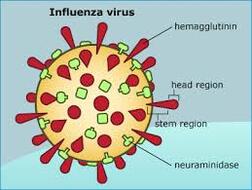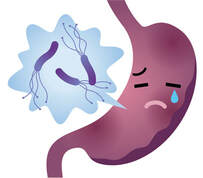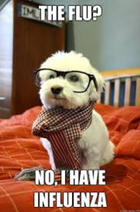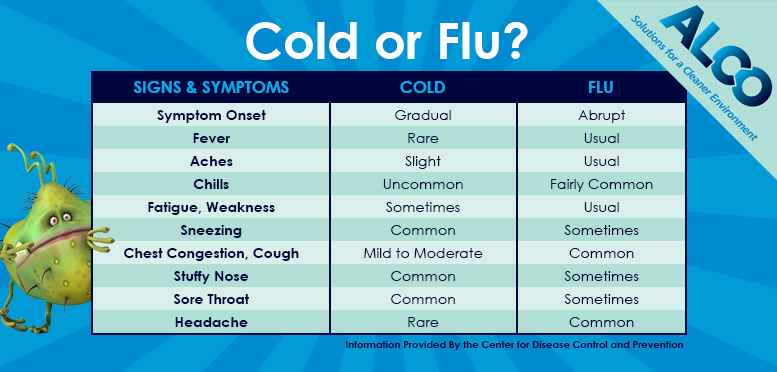What They Are, How They Spread & Prevention
The flu is an extremely contagious respiratory illness caused by influenza A, B or C viruses. Type A & B are what cause the annual influenza epidemics that affect up to 20% of the US population each year. Type C also causes the flu but the symptoms are much less severe. (There is a Type D that does not affect humans).  Type A
Type B
Type C
How Does Influenza Spread? Influenza can spread to others up to about 6 feet away! It is mainly spread though droplets made from infected people when the cough, sneeze or talk. Contamination can also occur when someone touches a surface with the flu virus on it and then touch their mouth, nose or possibly their eyes. According to the CDC, people are most contagious in the first 3-4 days their illness begins. Most healthy adults can infect others 1 day before symptoms start and up to 5-7 days after becoming sick. Children and people with weakened immune systems can pass the virus for longer than 7 days. Symptoms usually start 2 days after the virus enters the body. The Common Cold Symptoms Influenza and a common cold share similar symptoms which makes it difficult to distinguish the two. Generally cold symptoms are milder than the flu and people are more likely to have a runny/stuffy nose. The symptoms do not often lead to serious health risks either though people with weakened immune systems, asthma or conditions that affect the lungs and breathing passages may develop a serious illness such as pneumonia. Spread On average, adults will have 2-3 colds a year while children will probably have more. Most people will be fully recovered from a cold in 7-10 days. Many viruses can cause colds, but rhinoviruses are usually the culprit and are responsible for more than half of cold illnesses annually. There is no cure for the common cold. Why? There are over one hundred different strains of rhinoviruses out there which makes for a long list to eradicate/cure! Colds spread the same way as influenza – through coming into contact with a sick person or touching a contaminated surface and then your face.  Viral Gastroenteritis – The Stomach Flu The stomach flu is often confused with influenza but is very different. It is most often caused by norovirus, rotavirus or foodborne bacteria affecting the gastrointestinal system. The virus infects your cells and inflames the lining of your stomach and your intestines. Symptoms & Spread Viral gastroenteritis is very contagious. You can get it if you touch an infected person, a contaminated surface and then touching your face or by consuming infected food. Symptoms include vomiting, diarrhea, stomach pain/cramping and occasionally fever. Vomiting usually only lasts for 24 hours whereas diarrhea can last several days after that. Though it’s a miserable illness, it is typically not as serious as influenza with dehydration being the largest complication. It can be dangerous for older people, babies and people with other health conditions. Disease Prevention Flu Shot to Protect Against Influenza According to the CDC the number one way to prevent seasonal influenza is to get your flu shot every year. This protects you as well as people around you who may be more vulnerable to the virus. Proper Handwashing It can’t be stressed enough what proper handwashing techniques does to prevent illness. You should be washing your hands with soap for at least 20 seconds – a good rule of thumb is to sing “Happy Birthday” twice in your head. You should always wash your hands:
Though handwashing is the best way to remove germs, there will be instances when you do not have access to soap and clean, running water. In these situations, keep handy an alcohol-based hand sanitizer that contains at least 60% alcohol. Oooo feel the burn. Hand sanitizer is not a suitable substitute all the time particularly because it does not remove all types of germs, may not remove harmful chemicals and is not helpful when your hands are visibly dirty/greasy. To properly apply hand sanitizer, read the label for the correct amount then rub hands together until completely dry. To read more about proper hand washing, click here.  Properly Cleaning, Disinfecting and Sanitizing Handle and Prepare Food Safely – Use a food-safe sanitizer to clean counters where food is being prepared. Carefully wash fruits and veggies before preparation and consumption. Cook shellfish thoroughly. Food that might be contaminated with a virus should be thrown out and sick people should stay out of areas where food is being handled. Wash Laundry Thoroughly – It’s important to remove and wash linens or clothes that may be contaminated as soon as possible. You should handle soiled items carefully with gloves, washing your hands after the handling is done. Contaminated items should be washed with detergent and hot water at the maximum cycle length then machine dried at the highest heat setting. Clean and Disinfect Surfaces Properly – If necessary, clean an area before disinfecting it. Bring focus to high-touch areas such as doorknobs or light switches. Take care in choosing a disinfectant as not all of them have the same kill claims. Pay attention to dwell times. Disinfectants need to be on a surface for a specific amount of time in order to kill certain bacteria. Read the label and following instructions carefully. Always wear gloves and any other Personal Protective Equipment (PPE) required. To read more about disinfecting, click here. Do you feel like living in a bubble yet? Not our intention! Hope this blog was beneficial, if you have any questions then drop us a comment!
1 Comment
11/11/2019 06:09:28 pm
I never knew that the flu can spread from those who are contagious to others that are 6 feet away. I'm worried my son is going to catch the flu at school this year because of the number of people who are getting sick. It seems like it would be a good idea to take him to a doctor to get him vaccinated as an early precaution.
Reply
Your comment will be posted after it is approved.
Leave a Reply. |
Archives
April 2020
Categories
All
|
- Home
-
Products
- Aerosols
- Air & Surface Purification Technology
- Closed Loop
- Carpet Care
- COVID-19
- Degreasers
- Deodorizers
- Dietary/Kitchen
- Dishmachine Programs
- Disinfectants
- Floor Equipment
- Floor Cleaners
- Floor Care
- Floor Care - Gym
- Hand & Body Wash
- Janitorial
- Laundry
- Multi-Purpose
- Restroom Care
- Specialty
- Window Cleaners
- Resources
- Contact Us
- Blog
- Home
-
Products
- Aerosols
- Air & Surface Purification Technology
- Closed Loop
- Carpet Care
- COVID-19
- Degreasers
- Deodorizers
- Dietary/Kitchen
- Dishmachine Programs
- Disinfectants
- Floor Equipment
- Floor Cleaners
- Floor Care
- Floor Care - Gym
- Hand & Body Wash
- Janitorial
- Laundry
- Multi-Purpose
- Restroom Care
- Specialty
- Window Cleaners
- Resources
- Contact Us
- Blog
Actual product appearance may vary slightly from pictured item.





 RSS Feed
RSS Feed